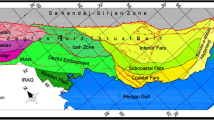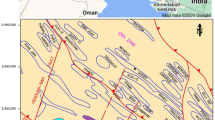Abstract
South Pars Gas Field is the largest gas field in the world. This field in the Persian Gulf and is located on the border of Iran and Qatar. In it, Dalan–Kangan formations are containing gas reservoirs. Evaluation and study of fractures in carbonate reservoirs is essential in the process of production and development of hydrocarbon fields. Core data and imaging logs are the most important tools in achieving this goal.in this study, using core data and image logs, Dalan–Kangan reservoir fractures in terms of distribution and relative orientation were investigated. Based on the results, both natural and closed fractures were present in large quantities in the studied well. In core data, the ratio of closed fractures filled with minerals was higher than other natural fractures. No major faults were observed in the wells studied and only a minor fault with a displacement of several millimetres was observed. The results of the FMI log showed 120 open fractures as well as 20 closed fractures. Open fractures often had a slope of 50 to 80 degrees and the azimuth was N74W and S80E. Their average aperture was 0.27 mm in the K4 section. Also, closed fractures were mostly in the two main directions of azimuth N48E and S84W with a slope of 51 and 63 degrees. The results of this study can be used to discuss field development and fabrication of fracture models as well as facies models.








Similar content being viewed by others
References
Aali J, Rahimpour-Bonab H, Kamali MR (2006) Geochemistry and origin of the world’s largest gas field from Persian Gulf, Iran. J Pet Sci Eng 50:161–175
Aghli G, Soleimani B, Tabatabai SS, Zahmatkesh I (2017) Calculation of fracture parameters and their effect on porosity and permeability using image logs and petrophysical data in carbonate Asmari reservoir. SW Iran. https://doi.org/10.1007/s12517-017-3047-4
Aghli G et al (2020) Reservoir heterogeneity and fracture parameter determination using electrical image logs and petrophysical data ( a case study, carbonate. Pet Sci 17:51–69. https://doi.org/10.1007/s12182-019-00413-0
Alavi M (2007) Structures of the Zagros fold-thrust belt in Iran. Am J Sci 307(9):1064–1095
Alsharhan AS, Nairn AEM (1994) The late Permian carbonates (Khuff Formation) in the western Arabian Gulf: Its hydrocarbon parameters and paleogeographical aspects. Carbonates Evaporites 9(2):132–142
Asgarinezhad Y, Tokamachi B, Kamkar-Rouhani AG, Sherkati S (2014) A combined Parzen-wavelet approach for detection of vuggy zones in fractured carbonate reservoirs using petrophysical logs. J Pet Sci Eng 119:1–7
Asgarinezhad Y, Asgarinezhad M, Tokhmechi B et al (2016) Detecting vuggy porosity in carbonate reservoirs by well logs. J Pet Explor Prod Technol 6:25–31
Bellahsen N, Fiore P, Pollard DD (2006) The role of fractures in the structural interpretation of sheep Mountain anticline. Wyom J Struct Geol 28(5):850–867
Bordenave ML, Hegre JA (2010) Current distribution of oil and gas fields in the Zagros Fold Belt of Iran and contiguous offshore as the result of the petroleum systems. Geological Society, London, Special Publications, 330(1), 291–353
Ehrenberg SN, Aqrawi AAM, Nadeau PH (2008) An overview of reservoir quality in producing Cretaceous strata of the Middle East. Pet Geosci 14(4):307–318
Einstein HH (2021) Fractures: tension and shear. Rock Mech Rock Eng 54:3389–3408. https://doi.org/10.1007/s00603-020-02243-8
Esrafili-Dizaji B, Rahimpour-Bonab H (2013) A review of permo-triassic reservoir rocks in the zagros area, sw iran: influence of the qatar-fars arch. J Pet Geol 36(3):257–279
Ezati M, Azizzadeh M, Riahi MA, Fattahpour V, Honarmand J (2018) Characterization of micro-fractures in carbonate Sarvak reservoir, using petrophysical and geological data. SW Iran J Pet Sci. Eng. 170:675–695. https://doi.org/10.1016/j.petrol.2018.06.058
Ghazban F (2009) Petroleum geology of the Persian Gulf. Tehran University Press, Tehran
Gudmundsson A (2011) Rock fractures in geological processes. Cambridge University Press, Cambridge
Gui Y, Bui HH, Kodikara J (2015) An application of a cohesive fracture model combining compression, tension and shear in soft rocks. Comput Geotech 66:142–157. https://doi.org/10.1016/j.compgeo.2015.01.018
Hancock PL (1985) Brittle microtectonics: principles and practice. J Struct Geol 7:437–457
Jenkins C, Ouenes A, Zellou A, Wingard J (2009) Quantifying and predicting naturally fractured reservoir behavior with continuous fracture models. AAPG Bull 93(11):1597–1608
Kashfi MS (1992) Geology of the Permian “Super-Giant” gas reservoirs in the greater Persian Gulf area. J Pet Geol 15(3):465–480
Khoshbakht F, Memarian H, Mohammadnia M (2009) Comparison of Asmari, Pabdeh and Gurpi formation’s fractures, derived from image log. J Petrol Sci Eng 67(1–2):65–74. https://doi.org/10.1016/j.petrol.2009.02.011
Khoshbakht F, Azizzadeh M, Memarian H, Nourozi GH, Moallemi SA (2012) Comparison of electrical image log with core in a fractured carbonate reservoir. J Petrol Sci Eng 86–87:289–296. https://doi.org/10.1016/j.petrol.2012.03.007
Khoshbakht F, Rasaie MR, Shekarifard A (2016) Investigating Induction Log response in the presence of natural fractures. J Petrol Sci Eng 145:357–369. https://doi.org/10.1016/j.petrol.2016.05.023
Khoshnoodkia M, Mohseni H, Rahmani O, Mohammadi A (2011) TOC determination of Gadvan Formation in South Pars Gas fi eld, using arti ficial intelligent systems and geochemical data. J Petrol Sci Eng 78:119–130
Konyuhov AI, Maleki B (2006) the persion gulf basin: geological history, sedimentary formations, and petroleum potential lithol. Miner Resour 41:344–361
Kulander B R, Dean S L, Ward B J (1990). Fractured Core Analysis: Interpretation, Logging, and Use of Natural and Induced Fractures in Core: AAPG Methods in Exploration Series, No. 8 Oklahoma, AAPG
Lai J, Wang G, Fan Z, Wang Z, Chen J, Zhou Z, Wang S, **ao C (2017) Fracture detection in oil-based drilling mud using a combination of borehole image and sonic logs. Mar Pet Geol 84:195–214. https://doi.org/10.1016/j.marpetgeo.2017.03.035
Laubach SE, Olson JE, Gross MR (2009) Mechanical and fracture stratigraphy. AAPG Bull 93(11):1413–1426
Luthi SM, Souhaite P (1990) Fracture apertures from electrical borehole scans. Geophysics 55(7):821–833
Nazari Ostad M, Asghari O, Emery X, Azizzadeh M, Khoshbakht F (2016) Fracture network modeling using petrophysical data, an approach based on geostatistical concepts. J Nat Gas Sci Eng 31:758–768. https://doi.org/10.1016/j.jngse.2016.03.084
Nelson R (2001) Geologic analysis of naturally fractured reservoirs, contribution in petroleum geology and engineering, vol 1. Gulf Professional Publishing
Pollard DD, Aydin A (1988) Progress in understanding jointing over the past century. Geol Soc Am Bull 100:1181–1204
Rider MH (1986) The geological interpretation of well logs, 2nd edn. Rider-French Consulting Ltd, Cambridge, England
Saedi G, Soleimani B, Samani B, Arzani A (2022) The interaction between faults and in-situ stress on the kinematic and subsurface natural fracture of Aghajari oilfield in southwest of Iran. J Pet Sci Eng 208:109567. https://doi.org/10.1016/j.petrol.2021.109567
Schlumberger (2002) Borehole geology, geomechanics and 3D reservoir modeling. Cambridge University Press
Solberg P, Lockner D, Byerlee J (1977) Shear and tension hydraulic fractures in low permeability rocks. Pure Appl Geophys PAGEOPH 115:191–198. https://doi.org/10.1007/BF01637103
Tadayoni M, Khalilbeyg M, Bin Junin R (2020) A new approach to heterogeneity analysis in a highly complex carbonate reservoir by using borehole image and conventional log data. J Pet Explor Prod Technol 10:2613–2629. https://doi.org/10.1007/s13202-020-00930-4
Zahmatkesh I, Aghli G, Mohamadian R (2015) Systematic fractures analysis using image logs and complementary methods in the Marun Oilfield, SW Iran
Acknowledgements
The authors consider it necessary to thank the research department of Shahid Chamran University of Ahvaz and the research department of the National Iranian Drilling Company for providing the necessary facilities and information for this research.
Funding
The authors state that they did not receive any funding at the time of writing.
Author information
Authors and Affiliations
Contributions
AM contributed to conceptualization, methodology, software, formal analysis, and writing – original draft. IZ contributed to software, validation, and writing- reviewing and editing. BS contributed to data curation, visualization, and investigation.
Corresponding author
Ethics declarations
Conflict of interest
The authors of this article state that they have no interest in competing.
Rights and permissions
About this article
Cite this article
Mohsenipour, A., Zahmatkesh, I. & Soleimani, B. Fractures Analysis Using Core Data and Image Logs: A Case Study in the Dalan–Kangan Reservoir of South Pars Gas Field, Iran. Iran J Sci Technol Trans Sci 46, 819–828 (2022). https://doi.org/10.1007/s40995-022-01288-4
Received:
Accepted:
Published:
Issue Date:
DOI: https://doi.org/10.1007/s40995-022-01288-4




